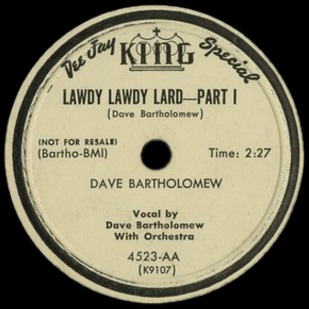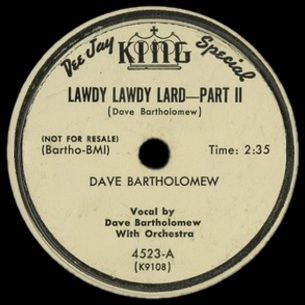Dave Bartholomew: “Lawdy Lawdy Lard (Pt. 1 & 2)”
17 Tuesday Jan 2023
Written by Sampson
Tags
No tags :(
Share it
KING 4523; MARCH 1952

Once upon a time religion in America was widely respected. It was considered the bedrock of the country’s founding, the guiding light to follow for living a good life and not something to be trifled with if you knew what was good for your everlasting soul.
Then people got smart.
Or should I say, then rock ‘n’ roll came along and people (quite literally as it turns out), changed their tune(s).
There may very well have been pre-rock songs that took a sardonic view of religion but the dominant cultural forces at the time largely saw to it that this commercialized blasphemy didn’t catch on. But with the arrival of rock ‘n’ roll – a genre that literally came about when Roy Brown used gospel vocals to sing about drinking and sex! – the lid suddenly blew off and in the spring of 1952 a number of songs began explicitly violating the third commandment.
Ya know, the one where the so-called all powerful creator of the universe shows he’s got the insecurity of a 13 year old.
Of course had he BEEN a 13 year old, he’d have loved this kinda thing.
Early One Morning
Wouldn’t you know it, but a girl seems to have been the source of all this sacrilege.
Whoever she was, this Clawdy sure got around in 1952. Of course in the eyes of the righteous flock that means she must be a sinner! This is why women belong in the home! Someone let this young hussy out into the streets where she turned the head of every man who walked by, some of whom then began taking the lord’s name in vain – there’s that pesky third commandment! – and singing her praises and calling attention to this affront to all that’s holy on three records released by three artists in fairly rapid succession.

The one we won’t be covering is Calvin Boze’s recent release Hey Lawdy Miss Claudie because it is no way rock ‘n’ roll.
Boze was a Louis Jordan doppleganger and was very convincing in that role, but he came along a decade too late to really take advantage of it commercially even though he was still popular enough with the demographic that had aged out of the prime buying market to sustain a career with his Jordan-impressions for awhile.
The ironic part of that song is how Boze is putting the girl down as she gets older, saying how at 29 she still might have some guys nibbling on her line, but at 38 it’ll be too late. He might just as well be talking about himself and the outdated music he was peddling in an age of rock ‘n’ roll.
Now of course the same title, with a different spelling, would soon be used by another singer for a totally different song that was at the forefront of rock just around the corner.
But in between the two comes Dave Bartholomew with Lawdy Lawdy Lard (note the interesting spelling in an effort to avert the censors), a two-part single cut at the end of January which prominently mentions Clawdy. I presume this is the same girl that Bartholomew would be dealing with six weeks later (just about the time this record was released in fact) when he led the studio band for Lloyd Price’s immortal song that brought the lady out of the shadows and onto the charts.
No word on God’s reaction to this scandalous young trollop who so many men were publicly linking with his only son, a well-known bachelor who by the sounds of it certainly must’ve gotten around himself back in the day.
Who May Your Lover Be?
Though the promo editions of this release tout Dave Bartholomew himself as the vocalist, the truth is it was Tommy Ridgley doing the singing, as he was a mainstay of Bartholomew’s band during this period.
It’s a good decision for while the vocals here sre ubiquitous, they’re tasked with reciting lyrics that are rather perfunctory and Ridgley’s tone is more agreeable to the rise and fall pattern of him whining about his lost love… the notorious Clawdy.
But Lawdy, Lawdy Lard isn’t really centered on the girl herself, but rather on the angst over losing her which is mostly confined to Ridgley’s agonized wails of despair. Obviously that’s not enough to fill a song, let alone a two-part song and so the responsibility falls to the music.
The main appeal of the record is the churning rhythm with piano, guitar and horns mixing together to keep this moving along. The slow boogie riff offset by a sprinkling of treble keys and then later on the gently pulsing horns combine to create multiple melodic/rhythmic lines to follow giving the record a certain depth to it, a Bartholomew specialty.

When the first instrumental break comes and the saxophone eases into the spotlight – either Clarence Hall or Herb Hardesty – the effect is simply to continue the surging forward momentum with a less rigid part to draw your attention somewhere new.
The whole thing is designed to be a versatile medium tempo dance record, but one which doesn’t favor any specific person on the floor. It’s slow enough to sway in someone else’s arms, yet quick enough to groove by yourself off to the side or to use to approach someone you don’t really know to ask them to dance because until you get familiar with one another you can still keep your distance with a pace like this.
The fact that it doesn’t stop at the end of Side One and that solo just keeps rolling along in the second part as the drummer’s nervous energy is channeled through the cymbals gives you as much time as you need on the floor.
Ridgley’s next appearance doesn’t even clear up any of the scant plot points, but rather just gives the band a platform to launch the next extended break, this one with all of the horns in tight formation playing a more rousing riff that parachutes at the end of each line to keep it from getting out of hand while the guitar and drums lock in that rhythm.
None of this is all that fancy, nor even memorable, but it never fails to keep your feet moving even as it acknowledges that you won’t really be paying attention while it plays. That may sound like criticism, but for what they were trying to do in the setting a song like this was designed for in the first place it’s a modest job done well.

Please Come Back And Stay
New Orleans wasn’t the birthplace of rock ‘n’ roll by accident, it was a cultural melting pot where music was the number one ingredient for a flavorful life and so it shouldn’t be surprising that this girl who created such a stir in music in 1952 came from the area.
But not necessarily standing on the corner or walking down the street.
WBOK disc jockey Okey Dokey had one of those non-sensical sayings that dee-jays loved to throw into their on-air patter… “Lawdy Miss Clawdy”, sort of a catch-all exclamation suitable for any purpose. Because the airwaves were open to all who wanted to listen, it’s no coincidence that multiple people exposed to it came up with the same basic idea around the same time.
That the one who got it down last turned out to make the biggest impact and seven decades down the road is the only one widely remembered is sort of ironic until you stop and remember it’s the best song with the best performances from top to bottom.
But the guy responsible for much of that record’s success actually beat it to the gate with Lawdy Lawdy Lard, a record that is made with largely the same band but with a much different purpose in mind.
Though King’s owner Syd Nathan would have preferred an easily digestible hit and had every right to be apocalyptic a month later when Dave helped get one of those for another label using the same basic thematic idea, chalk this up as the last stand of Dave Bartholomew bandleader before he transferred all of his energies to the producer’s chair with the same gal there to provide an easy transition.
Neat how that works out, isn’t it?
SPONTANEOUS LUNACY VERDICT:

(Visit the Artist page of Dave Bartholomew for the complete archive of his records reviewed to date)
